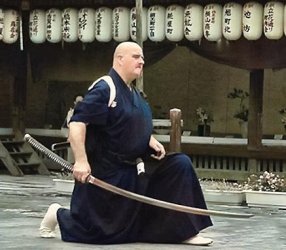I’ve been running a little (unscientific) experiment to see if modern methods of protecting steel from corrosion are more effective than traditional ways.
I wanted to compare ‘Break Free CO Collector‘ anti-corrosive properties with traditional sword (choji) oil.


Two shinken were cleaned using the traditional method every 2-3 months. One was oiled with choji oil (see above) and the other with ‘Break Free CO Collector’. Both were stored in the same gun case with silica gel desiccant packets.
I noted, when applying the two different oils, that the Break Free CO Collector tended to ‘bead’ on the blade surface. It was assumed that capillary action would distribute the oil over the blade surface in time, but this proved not to be the case. The choji oil, on the other hand, formed an even layer over the entire surface of the sword‘s blade.
After a year, the shinken oiled with Break Free CO Collector had tiny spots on the ura side of the monouchi. They felt rough to the touch and on inspecting with a jeweller’s loop, were identified as spots of rust. The choji oiled sword was free of any corrosion.
I can only conclude that the beading property of Break Free CO Collector left areas of steel unprotected and exposed to ambient oxygen and moisture, leading to corrosion.
In conclusion, I would recommend using traditional choji oil to protect shinken from corrosion.
I wanted to compare ‘Break Free CO Collector‘ anti-corrosive properties with traditional sword (choji) oil.
Two shinken were cleaned using the traditional method every 2-3 months. One was oiled with choji oil (see above) and the other with ‘Break Free CO Collector’. Both were stored in the same gun case with silica gel desiccant packets.
I noted, when applying the two different oils, that the Break Free CO Collector tended to ‘bead’ on the blade surface. It was assumed that capillary action would distribute the oil over the blade surface in time, but this proved not to be the case. The choji oil, on the other hand, formed an even layer over the entire surface of the sword‘s blade.
After a year, the shinken oiled with Break Free CO Collector had tiny spots on the ura side of the monouchi. They felt rough to the touch and on inspecting with a jeweller’s loop, were identified as spots of rust. The choji oiled sword was free of any corrosion.
I can only conclude that the beading property of Break Free CO Collector left areas of steel unprotected and exposed to ambient oxygen and moisture, leading to corrosion.
In conclusion, I would recommend using traditional choji oil to protect shinken from corrosion.

